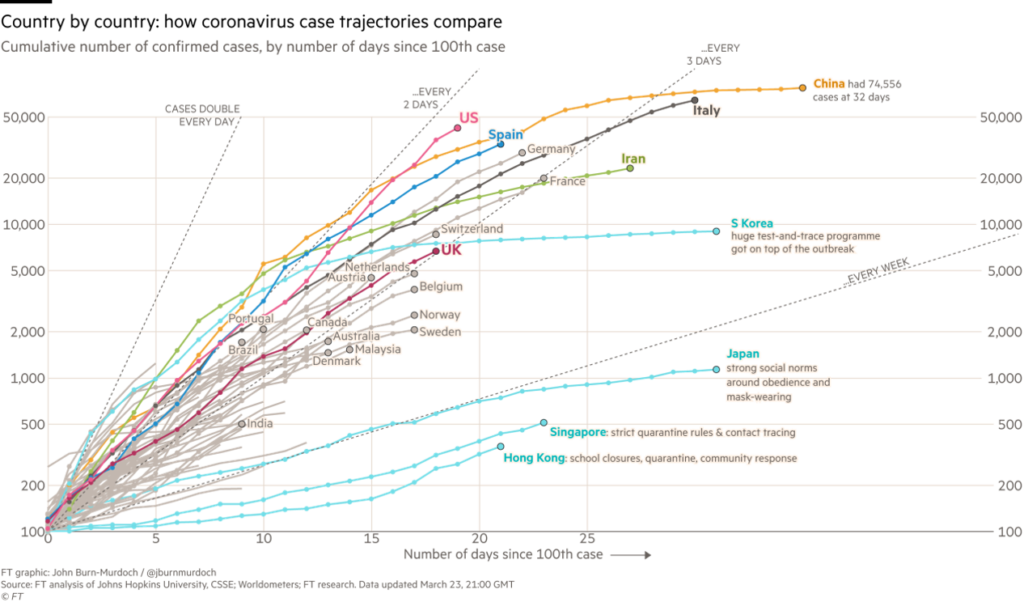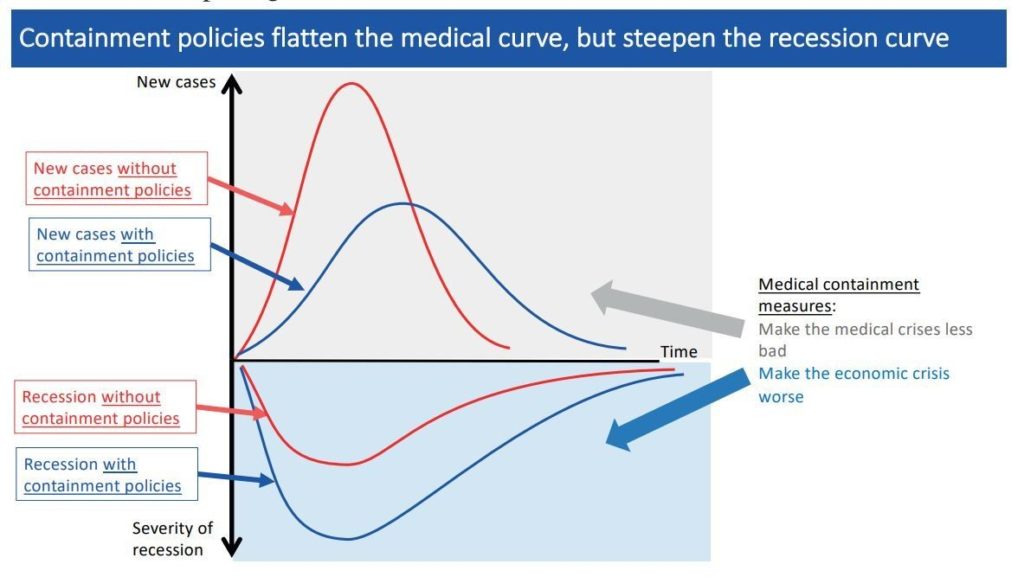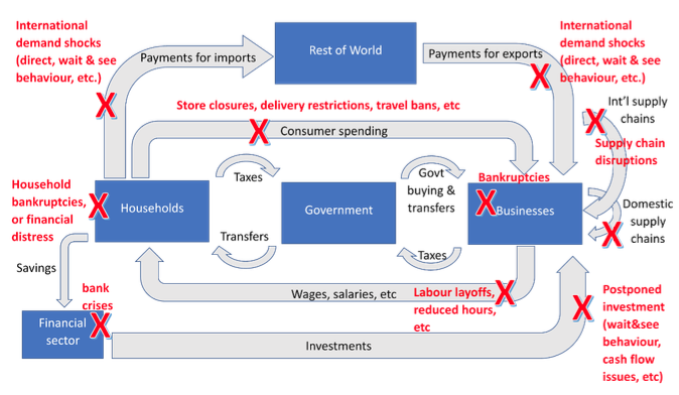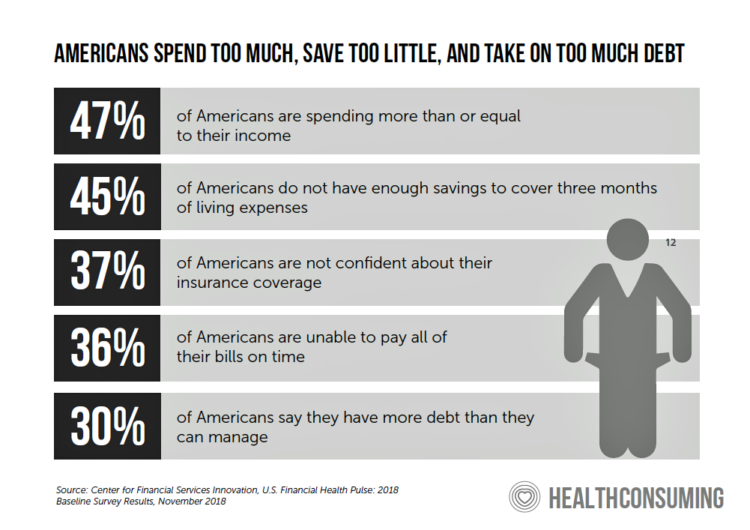 “Act fast and do whatever it takes,” insists the second half of the title of a new eBook with contributions from forty leading economists from around the world.
“Act fast and do whatever it takes,” insists the second half of the title of a new eBook with contributions from forty leading economists from around the world.
The first half of the title is, Mitigating the COVID Economic Crisis.
The book is discussed in a World Economic Forum essay discussing the economists’ consensus to “act fast.”
As the U.S. curve adds new American patients testing positive for the coronavirus, the book and essay illustrate the tension between health consumer versus the health citizen in the U.S.
For clinical context, as I write this post on 24th March 2020, today’s U.S. curve illustrating the trajectory of the number of days since the 100th COVID-19 case shows a steeper incline than any other nation’s. This graph was published today by the Financial Times, which is tracking the coronavirus each day and has generously dropped its paywall for this crucial content.
 The first of two charts in the essay, taken from the economists’ book, illustrates the physical factor: that is, the #FlattenTheCurve scenarios related to medical containment, and potential for economic recession.
The first of two charts in the essay, taken from the economists’ book, illustrates the physical factor: that is, the #FlattenTheCurve scenarios related to medical containment, and potential for economic recession.
The title of the chart makes it clear that, “containment policies flatten the medical curve, but steepen the recession curve.” This is the issue of “act now:” #StayHome, mandate social distancing nationwide across all fifty states and all U.S. communities, and essentially bite the bullet in the short-term to lessen the curve’s slope and conserve scarce health system resources — hospital beds, ventilators, masks, and most importantly, the labor on the front-lines of the COVID-19 pandemic: doctors and nurses who put themselves in harm’s way 24×7 from Seattle to New York City.
 The second chart illustrates the dynamics of the fiscal story of the COVID-19 pandemic: household economics, consumer demand for goods, supply chains, employers and business impacts.
The second chart illustrates the dynamics of the fiscal story of the COVID-19 pandemic: household economics, consumer demand for goods, supply chains, employers and business impacts.
Clearly, the healthcare story is embedded into the economic fabric of the country — this is true globally, but in the U.S. has the complication that so many Americans play the role of health consumer — the patient as the payor. At least one-third of people in the U.S. are concerned about their potential out-of-pocket costs which could run $1,300 or more, based on a Peterson Center/Kaiser Family Foundation study I discussed here in Health Populi.
Bottom-line for that health consumer: two in three Americans could not afford to pay their deductible if hospitalized for treatment of coronavirus.
The “Households” segment of the fiscal diagram identifies the financial impact to the consumer: household bankruptcies or financial distress. Beyond paying for food and housing, in the U.S., the individual is concerned about also covering medical costs. For COVID-19, this is a matter of what for oncology, analysts have termed “financial toxicity.”
Health Populi’s Hot Points: Eons ago, Virgil wrote, “The greatest wealth is health” We are now living through this interdependence globally, viscerally. Virgil lived between 70 BC and 19 BC, dying at the age of 51 years of age and living in poor health for much of his life.
2,000+ years later, we are wrestling with wealth and health, and the tension between short-to-midterm pain (physical distancing, financial stress, psychological needs) that can help conserve health system resources and save lives, and trade-offs with national and personal economies — shown in the fiscal graphic.
 In a section called “Self-rationing due to cost: fiscal vs. physical,” I wrote in my book, HealthConsuming: From Health Consumer to Health Citizen,
In a section called “Self-rationing due to cost: fiscal vs. physical,” I wrote in my book, HealthConsuming: From Health Consumer to Health Citizen,
“The costs of medical care have compelled people in America to take steps that self-ration, avoiding or postponing some aspect of medical care…[which also] happens among people with insurance who have trouble paying medical bills…While it’s more common for people with lower incomes to avoid healthcare due to cost, some 16% of consumers earning over $100,000 a year did so, too….”
This chart comes out of the book from the chapter, “The Patient is the Payor.”
The U.S. is the only country in the world facing the COVID-19 pandemic where the patient is that payor.
At this time of “war” against the pandemic, Americans should be, should feel like, Health Citizens. Throughout the country, we are seeing Americans doing noble things for each other, in their communities, for health care providers, for their families. These actions are those of Health Citizens who embrace both their rights (where health care should be as a civil right/universal health care) and responsibilities — like adopting the #StayHome & #AloneTogether life- and work-style, physical distancing, hygiene, and checking in with neighbors and friends using digital and social technologies.
The American reality remains that most people, health consumers/patient-payors, do not have the level of savings banked to cover health care costs in an emergency. And if ever there was a healthcare emergency, we’re in it Right Now.
Yesterday, President Trump stated at his daily broadcast conference that, “We cannot let the cure be worse than the problem.”
“Whose” cure? “Whose” problem?
Economics is the study of the allocation of scarce resources. Today, several thousand Americans are dealing with the situation of a loved one in an ICU where hospitals may have just enough ventilators to cover inpatients gasping for breath. Fifteen days from today, there will be tens of thousands of beloved inpatients in beds, in hospitals and makeshift care settings to cover the overflow of those very sick from the coronavirus complications. The supply-side of COVID-19 “wartime” hardware — beds, ventilators, perhaps even disposable masks — is forecasted to be in shortfall.
Leaders in the Pentagon are planning for several months to deal with the COVID-19 pandemic: “I think we need to plan for this to be a few months long at least and we’re taking all precautionary measures to do that,” Secretary of Defense Mark Esper said during a virtual town hall. The Chairman of the Joint Chiefs of Staff U.S. Army Gen. Mark Milley said, “You’re looking at eight to 10 to 12 weeks, call it three months, based on what we know from other countries like China, Hong Kong, South Korea, etc., that may or may not apply to the United States.”
President Trump wants to “open up” the economy by Easter, which will happen less than one month from today (25 days, by my count).
This would run counter to the advice of “acting fast” and “doing whatever it takes” to save patients and bolster the economy with sufficient resources to keep families financially whole.





 Interviewed live on BNN Bloomberg (Canada) on the market for GLP-1 drugs for weight loss and their impact on both the health care system and consumer goods and services -- notably, food, nutrition, retail health, gyms, and other sectors.
Interviewed live on BNN Bloomberg (Canada) on the market for GLP-1 drugs for weight loss and their impact on both the health care system and consumer goods and services -- notably, food, nutrition, retail health, gyms, and other sectors. Thank you, Feedspot, for
Thank you, Feedspot, for  As you may know, I have been splitting work- and living-time between the U.S. and the E.U., most recently living in and working from Brussels. In the month of September 2024, I'll be splitting time between London and other parts of the U.K., and Italy where I'll be working with clients on consumer health, self-care and home care focused on food-as-medicine, digital health, business and scenario planning for the future...
As you may know, I have been splitting work- and living-time between the U.S. and the E.U., most recently living in and working from Brussels. In the month of September 2024, I'll be splitting time between London and other parts of the U.K., and Italy where I'll be working with clients on consumer health, self-care and home care focused on food-as-medicine, digital health, business and scenario planning for the future...